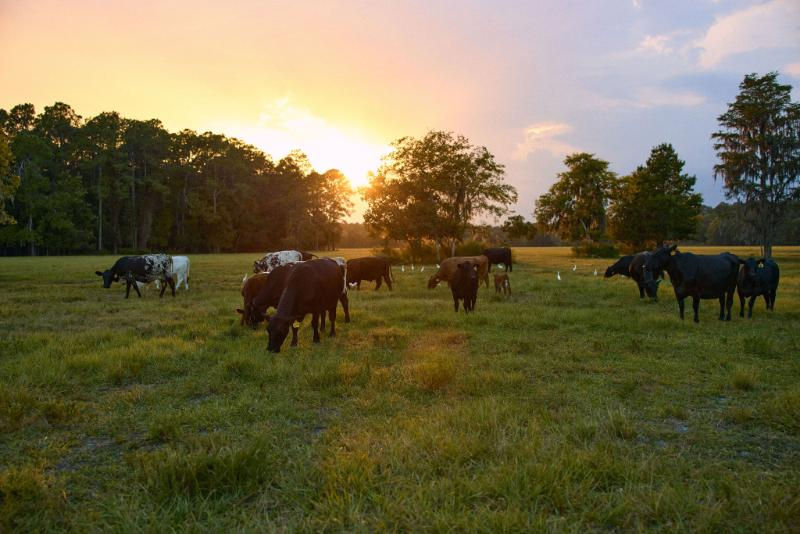Moo-vers and Haymakers: Grass-fed Cattle Farming
- MJ Anderson
- Nov 11
- 4 min read
What’s the secret to successful regenerative cattle farming? Turns out, it's not just about cows—it has a lot to do with grass.

The color of the grass, the types of grasses popping up, which kinds cows prefer or avoid, when to mow it and even how short to take it down (or how long to leave it). According to Kyle Harper, owner and operator of Clover Farms of Florida, his approach boils down to one word: observation. Harper recognizes the importance of really watching what's going on with the grass and within his herd. Rather than trying to systematize everything, he takes a different approach—watch first, then act accordingly.
Clover Farms is a two-part operation: a cattle farm in Baldwin and an egg farm in Starke. Harper has been around farming his whole life, but he started Clover Farms in 2014 when he left his corporate job to return to his roots. His focus from the beginning has been on sustainable and humane practices. "I believe that working with nature and with the land is better for the environment, better for the livestock and better for us," says Harper.
Holistic cattle farmers often emphasize that cows' digestive systems aren't meant to process grains, particularly those derived from chemically treated corn and soy. Grass is high in fiber and low in starch, which is what cows' stomach microbiomes thrive on; grain is the opposite.
So what happens when there hasn't been enough rain, it's hot out and the grass isn't growing well? Harper brings in hay (dried grass) for the herd to eat, which makes the cows do a little happy dance. "You should see them when I bring out a fresh bale of hay," he says with a laugh.
When shopping for high-quality beef, the term “grass-fed” is important, but so is “grass-finished.” If it doesn't say grass-finished or 100% grass-fed, the animal may have been fed grain for the last three to six months of its life, undermining many of the benefits of a more natural diet.
With grass and other forage being the ideal diet, the most natural place to raise cattle is a pasture – a piece of land that's managed to support grazing. The term “pasture-raised” implies animals with ample space to roam about and eat, and it can apply to a number of different livestock, from cows and chickens to sheep, goats and even pigs.
"A true pasture-raised system," Harper says, "would contain the least amount of inputs to still maintain high-quality pastures." Pasture-raised may mean that animals are completely free to roam or that they're rotated through different sections of the land. "Either way, they need to have enough space," he says.
The essence of regenerative agriculture is looking at the bigger picture and applying practices that create healthier soil and animals over time. This is especially relevant in cattle farming because cows naturally contribute to soil quality. Manure and urine act as fertilizer, and as cows graze, their
waste is gradually worked into the earth via their body weight and strong hooves.
"The ground in the pasture should ideally be well covered with grass," says Harper. "You don't want to see bare spots with just dirt. Soil temperature affects how well the grass grows, so the more coverage the better."
The soil microbiome, recharged by cattle activity, increases the levels of grass nutrients, which in turn increases the nutritional quality of the meat. On average, regenerative cattle farmers have much lower veterinary bills because their animals are healthier.
All in all, it's an integrative approach that involves observing the cows, watching the grass and considering weather patterns, then mowing and bringing in supplemental hay as needed.
Larger farms may also choose to use regenerative and holistic approaches. Harper mentions a farm partner in southern Georgia that has a 100-acre center pivot irrigation system. This allows them to water their grass consistently for regular growth, reducing the need to supplement with hay. And with the right ratio of cows to land, farmers can intentionally move the herd to different sections of the pasture, concentrating the benefits of grazing.
"We'd like to expand our herd and rotate them within the pasture, but for now it's not necessary," says Harper.
The combination of the terms pasture-raised, grass-fed and grass-finished are important because using just one or the other approach doesn't ensure that the cattle have been raised in an ethical or regenerative way. The USDA Organic label is generally trustworthy as well, because it means the farm has gone through processes to prove that the animals were allowed to roam in a natural environment and eat a diet without antibiotics, hormones or genetically engineered grains. However, after initial inspection, there are not regular on-site inspections.
The best way to ensure the quality of your food is to chat with farmers like Harper from Clover Farms and, if possible, visit their farms. While navigating labels and terms can feel overwhelming, the truth is refreshingly simple: the healthiest and most respectful farming practices are the ones that work with nature, not against it. Less input, more observation. Less interference, more trust in the land and the animals that graze it.


















Comments